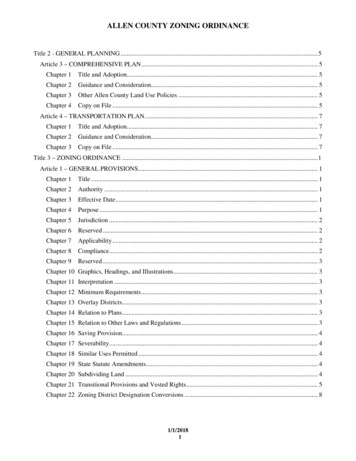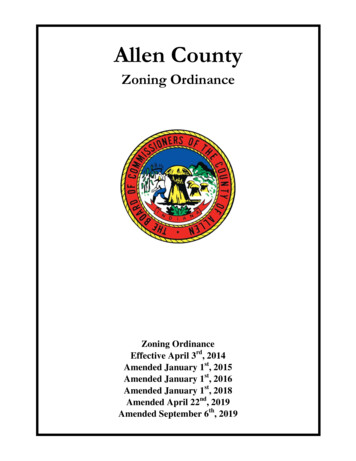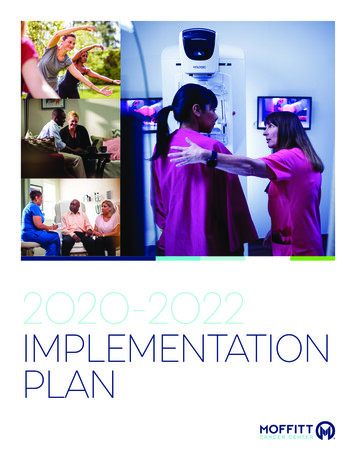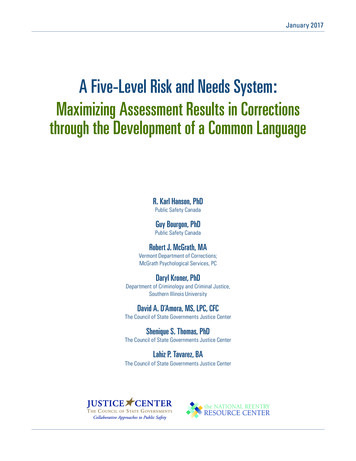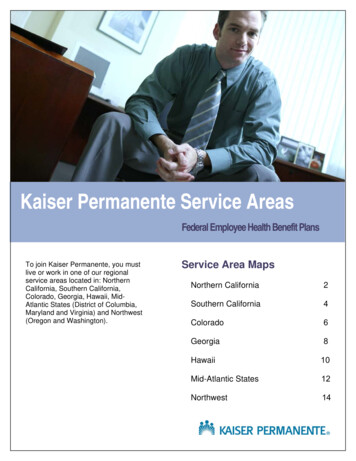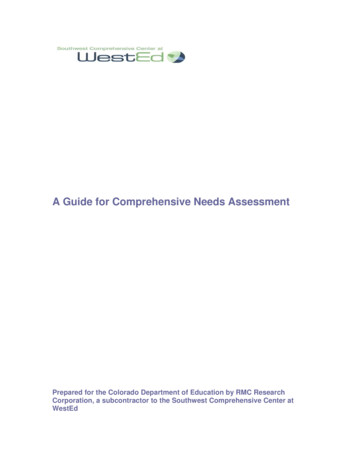
Transcription
A Guide for Comprehensive Needs AssessmentPrepared for the Colorado Department of Education by RMC ResearchCorporation, a subcontractor to the Southwest Comprehensive Center atWestEd
This work was developed by the Southwest Comprehensive Center at WestEd under agrant from the U.S. Department of Education. However, these contents do notnecessarily represent the policy of the Department of Education and you should notassume endorsement by the Federal government.The Southwest Comprehensive Center at WestEd, in partnership with RMC ResearchCorporation, is part of the federal network of sixteen Regional Comprehensive Centersserving individual or clusters of states.April 4, 2008
ContentsWhat Is a Needs Assessment? . 1Why Conduct a Needs Assessment?. 2Dimensions of a Comprehensive Needs Assessment . 3Components . 3Focus. 4Information Gathering . 4Planning Teams. 4Use of Results . 5Planning for Comprehensive Needs Assessment . 5Data Collection and Analysis. 9Gathering Existing Data . 9Student Demographics. 9Student Achievement Data. 9Curriculum and Instruction . 10Professional Development . 10Technology . 11Family/Community Involvement Measures . 11Early Childhood Assessment Data. 12Gathering New Data . 12Data Collection Logistics . 12Collecting Valid and Reliable Data . 12Data Analysis. 13Prioritize Needs . 13Identify Root Causes . 13Summarize Findings . 14Making Decisions. 14Reporting Needs Assessment Results . 14Comprehensive Planning . 15Unified School Improvement Planning . 15District Improvement Planning . 16Taking Action . 17Implementing Strategies to Meet Needs . 17Example Needs Assessment: Low Achievement in Reading . 18
Needs Assessment Activity: Needs Assessment for Use of Title II, PartA Funds. 20ReferencesAppendicesChecklist of Essential Needs Assessment StepsFederal Legislation SummariesConsolidated Application Needs Assessment Requirements
What Is a Needs Assessment?The phrase “needs assessment” is used rather loosely in the educational vernacular. As currentlyimplemented, a needs assessment can mean anything from asking individuals connected witheducation what they need to close the gap between current status and some desired state, such asall students reaching proficiency, to conducting a comprehensive research project, complete witha specified set of procedures such as statistical analysis, case studies, and student focus groups.In both cases, there is an attempt to assess or measure a perceived or actual need by collectingdata to document a challenge that exists. For federal programs, typically this means that localstaff must collect data that help illuminate the path to improvement.Various funding programs within the No Child Left Behind (NCLB) Act have specificrequirements for conducting a needs assessment. The requirements are presented in theAppendix. Generally, the requirements are as follows:Title I, Part A (basic programs for students from economically disadvantaged backgrounds)staff with schoolwide programs must conduct annual comprehensive needs assessments thatinclude analyses of student achievement data relative to proficiency expectations and involveparents and community members, teachers, principals,administrators (including those from other Title Iprograms), and if appropriate, pupil services personnel,technical assistance providers, school staff, and students,if for a secondary school. The overall purpose of thecomprehensive needs assessment is to “identify gapsbetween the current status of the school and its vision ofwhere it wants to be, relative to key indicators or focusareas” (Nonregulatory Guidance, p. 14). The guidancesuggests using a needs assessment process that includes establishing a schoolwide planningteam, clarifying the vision of school reform to identify school strengths and weaknesses, creatingthe school profile, identifying data sources for the needs assessment, and analyzing the collecteddata. The section on creating a school profile (Nonregulatory Guidance, pp. 10-13) contains anumber of questions that might be used on a comprehensive needs assessment. Schools withtargeted assistance programs are also to conduct a needs assessment to determine those childrenwith the greatest need to be served. In these schools, if health, nutrition, and other socialservices to address needs (such as basic medical equipment—eyeglasses and hearing aids, aprogram coordinator, or professional development about identifying and meeting these children’sneeds) are identified by a comprehensive needs assessment, some funds can be used to fill theseneeds through a collaborative partnership with local service providers.Title I, Part C (migrant education) programs must identify the special educational needs ofmigratory children as part of their comprehensive planning process. The state education agency(SEA) often takes the lead and plans a needs assessment in conjunction with local and stateprograms that receive federal funds.1
Title II (high quality teachers (HQTs) and principals) programs are to conduct needsassessments to determine the knowledge and skills needed by teachers and the instructionalleadership skills required of principals to ensure that students meet standards. Teachers atindividual schools must be involved in the needs assessment process. While no specific types ofdata are required, the law suggests that the needs assessment include: Student achievement data; Information on national and state initiatives; Anticipated professional development needs of core subject area teachers; Anticipated teacher supply and demand; Student enrollment data; Results of program evaluations; and Input from community and business.Funds are to be used to target those activities most likely to improve instruction and studentachievement.Title III programs (English language learners [ELL] and immigrant students) must include adescription of the need for their programs in their applications. The needs assessment mustinclude numbers of students who are designated as being limited English proficient (LEP) in theschool district to be served and information on the students’ characteristics including their nativelanguage, their proficiency in English and in their native language, achievement data inreading/language arts and mathematics, a comparison of achievement data for ELL and non-ELLstudents, and a summary of the previous schooling experiences of the children. The assessmentalso should reflect the professional development needs of the instructional personnel who willprovide services to the ELL students.Title V also specifies that needs assessments for programs that receive character educationfunds, the needs of gifted/talented students, and local needs for innovative programs are to bedetermined.Why Conduct a Needs Assessment?The requirements for program-level needs assessments areconnected to the purpose of the program. For example, sinceTitle I exists to help students to reach proficiency and close theachievement gap, the needs assessment requirements are there todiscover the challenges related to goals. In this case, the researchshows that attendance; parent involvement; school climate;leadership; and students being on grade level on assessments of2
reading, language arts, and mathematics are all related to students doing well on summative testssuch as the Colorado Student Assessment Program (CSAP). Measuring these predictors of testscores shows where some of the needs may lie.A needs assessment also: Provides direction for programs, projects, and activities; Allows staff to determine priorities and allocate limited resources to activities that will havethe greatest impact; Creates cohesion through the alignment of goals, strategies, professional development, anddesired outcomes; Enables benchmarking and monitoring of implementation and impact; and Assists with continuous improvement activities by helping staff identify change, whichinstructional and other practices are working, and the strategies associated with the greatestsuccess.Dimensions of a Comprehensive Needs AssessmentComponentsThere is no single best way to conduct a needs assessment. Rather, the components in a needsassessment should be determined by local context. The state of Massachusetts (2008) hasidentified some common or suggested components or characteristics of a needs assessment: Considers a range of needs or issues; Includes information gathered from a variety of sources; Employs the use of valid and reliable data to the maximum extent possible; Meaningfully involves many individuals representing a range of knowledge, skills andexpertise; Results in the development of goals and action plans; Used as the basis for resource allocation; and Includes regular follow up and evaluation of plans and strategies.3
FocusAssessment of needs should focus on those factors that have the potential to impact theachievement of students. At a minimum, needs assessments should address: test score results inthe aggregate and for subgroups, dropout rates, student mobility, attendance rates, and graduationrates. Curriculum and instruction issues should also be examined, including alignment withColorado Model Content Standards and assessment frameworks. Professional developmentneeds should also be assessed including teacher qualifications, the nature of professionaldevelopment, and planning time for teachers. Family and community involvement should beexplored and should involve communication with parents aboutstudent achievement, their involvement in decisions, supportsprovided to families, and/or business partnerships. School anddistrict organization provide contextual information that isimportant for framing needs. Vision, mission, decision-makingstructures, central office support, and budgetary issues are somecontextual factors to consider.Information GatheringInformation in a comprehensive needs assessment is gathered from a variety of sources.Quantitative data sources include CSAP scores, CSAP Alternate (CSAPA) scores, ColoradoEnglish Language Acquisition (CELA) scores, Colorado ACT results, adequate yearly progress(AYP) status and School Accountability Report (SAR) status and information. Graduation rates,attendance rates, and demographics should also be included. If schools use other standardizedformative or summative assessments, they should be addressed. Qualitative data, such as thatcollected through focus groups, interviews, written surveys, or classroom observations, are alsohelpful.Planning TeamsA formal planning team is a critical part of a comprehensive needs assessment. Acomprehensive needs assessment should include stakeholders that represent all parts of thesystem. Superintendents, central office staff, principals, teachers, paraprofessionals, schooloffice staff, parents/guardians, community members, and students all have important informationabout the system.4
Use of ResultsA comprehensive needs assessment results in the development of goals and action plans. Afterthe analysis of quantitative and qualitative data is completed, goals should be identified, andaction plans should emerge from those goals. For example, performance targets should be set formeeting AYP, and strategies for meeting those performance targets should be clearly articulatedwith action steps.Comprehensive needs assessment can be a powerful resource allocation tool. Often schools andschool systems are operating with limited resources. Results from a comprehensive needsassessment are a useful tool for prioritizing how resources will be used.To determine whether resources have been allocated in the proper fashion and the strategies usedto meet needs are effective, it is important to monitor whether needs, or the gap between what isand what should be, have been impacted. If gaps are not being reduced, evaluation can helpdetermine whether strategies are being executed properly, or whether other strategies should beattempted.Planning for Comprehensive Needs AssessmentA series of steps to plan a comprehensive needs assessment includes:1. Constitute a needs assessment committee.The formation of a needs assessment committee (NAC) is a powerful,efficient strategy for task completion. Larger groups are helpful for advising on or reactingto documents, but the dynamics of these larger groups are not always conducive to efficientdecision making. A core NAC group may consist of five to seven people. Largercommittees are helpful for reacting to drafts of reports. Subcommittees are an alternative ifthe committee is large. It is helpful to have committee members with expertise in collectingand analyzing data. Constituencies within the district should also be included on thecommittee, and organizational leadership should be part of the committee structure.2. Who needs to be involved in data gathering?A comprehensive needs assessment involves collecting data from multiple sources andaudiences. While it is not necessary to include all stakeholders in every single needsassessment, a plan that is broad enough in scope, yet detailed enough to collect sufficientinformation, is important. There will always be cost-benefit tradeoffs, but a good mixture ofbreadth and depth will provide the most comprehensive picture of needs. It is important tohave administrators and staff involved in the needs assessment process in order to maintainthe kind of momentum necessary to ensure that results are used.5
a. Key district and school personnelDepending on the size of the school district, a number of persons are essential to theprocess of conducting a comprehensive needs assessment. Accountability andassessment staff at the district level have a wealth of information, as do personnel inbudgeting offices and planning divisions; curriculum and instruction; administrators offederal programs; and support staff. It is important to conduct an internal scan of thedistrict’s resources and staff skill sets so that key personnel can be involved.b. External stakeholdersIn federal programs, there are a number of external stakeholders to consider, includingparents and guardians and the community. Depending on the circumstances, it might bewise to include business leaders, members of theChamber of Commerce, leaders of communityorganizations, providers of services to families andchildren, or other public agencies. Many times, theseexternal stakeholder groups will have conducted needsassessments of their own, and those data can beextremely helpful. Moreover, including them in theneeds assessment process contributes to stakeholderengagement later in the process.3. Prepare management plan.Comprehensive needs assessments can be lengthy endeavors, so it is important to have amanagement plan to guide efforts and keep the assessment on track. It is also important toconsider when results of needs assessment will be made available so that they can be usedeffectively. Results from a needs assessment are no longer reliable or valid if too much timehas passed.4. Identify issues and concerns.Using the expertise of the NAC, it is possible to quickly identify major issues and concernsthrough any number of brainstorming activities. Issues and concerns can be organized bygoal areas and then priorities for assessment can be established.6
5. Identify measures.The most common measure used in needs assessments aresurveys. Surveys are powerful, efficient, and reliable tools forcollecting data. However, a comprehensive needs assessmentdoes not rely upon surveys alone. A comprehensive needsassessment uses multiple sources of data that are triangulated.Triangulation refers to using three or more sources or types ofdata to establish the validity of a finding. For example, parents, paraprofessionals, andteachers may all be asked about the reading needs in a school. If their reports essentiallyagree, then the NAC can be relatively sure that the findings are reliable and valid. However,if there is a divergence of opinion, further investigation is warranted.6. Decide preliminary priorities.After needs have been identified, it is time to make preliminary decisions about priorities.Does the NAC have all of the information it needs? Does the NAC have to collect newinformation? From whom? At what cost? How long will it take? Who should be involved?Answering these kinds of questions will make it easier to decide what really needs to bedone.7. Designing a comprehensive needs assessment.A comprehensive needs assessment addresses multiple education issues. For example,schools with migrant students could assess the special needs for migrant education by talkingwith teachers, administrators, district personnel, parents, and the migrant studentsthemselves. The NAC should also examine student achievement disaggregated by migrantstatus to look for gaps and to pinpoint problems.For Title II, the NAC should explore needs related to the shortage of (HQTs). Interviewswith or surveys of HQTs could reveal some important patterns. Interviews, focus groups, orsurveys of teacher training institutions, such as Colleges of Education, might revealimportant information about providers of professional development. Principals in schoolbuildings and administrators at the district level who work with teachers can also provideinsight.8. Identify measures to use.A comprehensive needs assessment involves collection of data from multiple sources. Whilesurveys are the most common measure used, there are many other valuable sources of datathat already exist in schools and districts. Table 1 displays some of the more commonsources of data that may be used in a comprehensive needs assessment.7
Table 1. Common Sources of Data for Comprehensive Needs AssessmentSourceSurveysCommentsSurveys are efficient, easy to administer and provide accessible data.InterviewsInterviews are an excellent way to explore issues that are not well understood, or to gaincritical information from key stakeholders. They provide opportunity for follow-upquestions or to allow interviewees to elaborate on issues important to the school or district.Focus GroupsFocus groups are an efficient way to test ideas with groups and to generate novel thinkingand solutions to problems. When participants interact with one another, novel ideas orsolutions often emerge.ObservationsObservations of classrooms, after-school programs, summer programs, staff meetings, andcommunity meetings provide excellent information about the functioning of organizationssupporting the education of children.Document AnalysisA wide variety of documents have the potential for contributing to the needs assessmentprocess. These documents include, school improvement plans, district improvement plans,annual reports, budgets, meeting minutes, local media coverage, and school board agendas.Program EvaluationsMany projects funded internally or externally by the district, state, the federal government,or foundations often require evaluations of their efforts. These evaluations are powerfulsources of information for needs assessment. Not only do these reports identify problemsbeing addressed, they also make data-based recommendations for project improvement andthe effectiveness of projects and programs.BudgetsBudgetary documents are an excellent source of information about what the school, district,or organization thinks is important. For example, the percentage of funding allocated toprofessional development is a good indicator of priorities.Strategic Planning DocumentsSchools, districts, local businesses, public agencies, or community organizations that haveengaged in a strategic planning process often have valuable documentation to share.Strategic plans typically look at internal capacity, changing external circumstances, andidentify gaps in ways that are particularly informative with regard to the needs assessmentprocess.Environmental ScansEnvironmental scans, or those efforts to locate the important new educational developments,provide valuable information about internal capacity and external conditions relevant toschools, districts, and stakeholders.ProposalsMany funders require those responding to Request for Proposals (RFPs) to use a data-basedapproach to identification of needs to be addressed. Quite often, these needs assessmentsare specific to a particular effort, but can provide valuable information for a morecomprehensive approach.Research ReportsResearch reports produced about the school or district are excellent sources of information,particularly if they are contextualized. Many research reports review current literature thatpertain to studies conducted locally and can serve as a source of scientifically based research(SBR) related to the schools and districts if they are rigorous.Census DataCensus data population estimates, monitoring of trends, and tracking of other demographicinformation are a valuable source of information for determining school or district needs.The Small Area Income and Poverty Estimates (SAIPE) program produces annual estimatesof income and poverty for school districts.Suggestion BoxesWhen internal and external stakeholders are provided the opportunity to suggestimprovements, many needs may emerge.8
Data Collection and AnalysisData collection and analysis consists of three parts: collecting existing data, collecting new datato address the gaps not covered by existing data, and analyzing data to identify needs. Each ofthese activities will be covered in some detail.Gathering Existing DataSchool districts typically have plenty of data that will inform a comprehensive needs assessment.Some of the most useful sources of existing data will be described here. It is important toremember, however, that data have time value—they are sometimes no longer relevant after acertain period of time. Efforts should be made to collect and use the most recent forms of dataavailable for comprehensive needs assessment.Student DemographicsChanging student demographics is one of the biggest challenges schools face. As neighborhoodschange, mature, and are reborn, the populations of students served byschools shift in important ways. The most prominent shifts relate tosocioeconomic status and language spoken at home. Family structure isalso an important consideration. For example, it is important forschools to know the number and percentage of single parenthouseholds. The number of births during the year in a community helpsschool districts forecast and plan for resource needs into the future.Families and households without children are also important, becauseextra effort will be needed to ensure that school bond elections aresupported when numerous residents in the community do not have children in school.Student Achievement DataThere are many types of student achievement data collected in schools, and some are moreappropriate than others for conducting comprehensive needs assessments. Formative assessmentmeasures are typically collected to improve a program or activity, while summative measures aretypically used to compare program approaches to one another, or to make ultimate judgmentsabout an effort’s effectiveness. In the classroom, formative assessments are typically used toinform teachers how well their students are doing in terms of strengths andweaknesses. Formative assessments might be administered several times ayear. If formative assessment information is made available to teachers in atimely fashion, they have a powerful tool that can help them identify needs.Formative assessments are also an excellent tool for identifying building anddistrict needs since they can reveal patterns of learning strengths andchallenges.9
Summative assessments, such as the CSAP, provide data that are used to determine AYP. Whilethis is their primary purpose, they can also be used as another source of information foridentifying gaps or needs areas if processed correctly. It is important that results from tests likethe CSAP be used with caution. Some of these tests have very specific purposes, and it is riskyto use them for other purposes without understanding the pitfalls involved. Your districtassessment director should be able to provide more information about the use of tests for needsassessment.Data become more powerful when they are disaggregated. Disaggregation categories requiredby NCLB include race, ethnicity, gender, disability status, migrant status, English proficiency,and status as economically disadvantaged. When formativestudent achievement data from these subgroups are analyzed, gapsin performance can be discovered. With formative assessments,teachers and administrators can identify strategies to address thegaps, and make data-based judgments about which strategies seemto work best with which groups.Curriculum and InstructionCurriculum and instruction are at the core of the schooling process. Some questions that mightbe asked about curriculum include: Is the curriculum aligned with state frameworks and assessments? What kinds of instructional approaches are used most often? How effective is instruction for all groups of students? How are different types of instruction related to student achievement, and under whatcircumstances?Curriculum audits have been around for some time and more recently, instructional audits arebeing performed in many sites. These audits can provide valuable needs assessment data.Professional DevelopmentWhen identifying needs, professional development offerings, professional development ratings,and the overall coherence of professional development offered by a school district are importantcharacteristics to examine. Teacher surveys are the most common way to identify perceivedneeds for professional development offerings. However, professional development needs shouldalways be linked to achievement goals and reflect the priorities of the school district. Ifdisaggregated data analysis reveals that there are achievement gaps between groups, professionaldevelopment needs assessment should be targeted to understand the reason for thoseachievement gaps. If students are not achieving at uniformly high levels across the schooldistrict, additional inquiry might be warranted to determine exactly why.10
TechnologyTechnology needs should be carefully identified, and plans for meetingthose needs should be grounded in firm needs assessment data. Coloradohas teacher and administrator standards for technology. The purchase ofmajor technologies should align with school or district vision, mission,and goals, and technology needs should be directly linked to studentachievement.Family/Community Involvement MeasuresChildren who have parents or guardians involved in their education are more likely to besuccessful. Parent involvement in schooling can take on many forms, and these forms allcontribute to the success of students. E
data are required, the law suggests that the needs assessment include: Student achievement data; Information on national and state initiatives; Anticipated professional development needs of core subject area teachers; Anticipated teacher supply and demand; Student enrollment data; Results of program evaluations; and



